I arrived in Astana, Kazakhstan’s rather unconventional capital, after an epic 39-hour train journey across the country’s vast steppes. Unlike other cities in Central Asia, Astana stands out for its ultra-modern skyline, futuristic architecture, and planned layout. It feels less like a traditional Central Asian city and more like a major hub in Eastern Europe. In contrast to cities like Dushanbe, Bishkek, and Tashkent, which are shaped by Soviet-era architecture and local culture, Astana seems designed to project a sleek, forward-looking image.
Among its most peculiar landmarks are a 62-metre-tall glass pyramid, a flower-shaped concert hall, and a flying-saucer-inspired circus. And then there’s Baiterek – a tower shaped like a giant lollipop that was apparently designed by the president himself.
It’s all the more astonishing when you consider that, just 28 years ago, this city didn’t exist. In 1997, President Nursultan Nazarbayev moved the capital from Almaty in the southeast to a scarcely developed settlement called Akmola – a place better known at the time for being a former prison camp for the wives of alleged Soviet traitors. It was renamed Astana (which literally means ‘capital city’ in Kazakh), and quickly transformed from a remote outpost into the flashy administrative heart of the nation.
Since then, the city’s population has skyrocketed to over 1,5 million. But even with this growth, many of Astana’s buildings feel dramatically outsized, and seem built for a city many times its population size. The Astana Arena accommodates up to 30,000 spectators, while the Grand Mosque can hold an astonishing 235.000 worshippers – roughly 16 % of the city’s entire population! The parks are vast but eerily deserted. The malls, mostly empty. The streets too. The only place you really feel the city’s bustle is in the traffic.
Step just beyond the edge of the city, and the illusion of Astana as an authentic city shatters. The emptiness continues – nothing surrounds the city for over 200 kilometres except the vast, flat expanse of the steppe, a featureless ocean of grass interrupted only by a few small towns. This is what makes Astana so fascinating. It feels less like a city and more like a philosophical experiment: a human attempt to defy the terrifying emptiness of the steppe through sheer force of architecture and ambition. A surreal outpost in the void, Astana is both a symbol of national pride and a strange monument to the power – and limits – of human will.
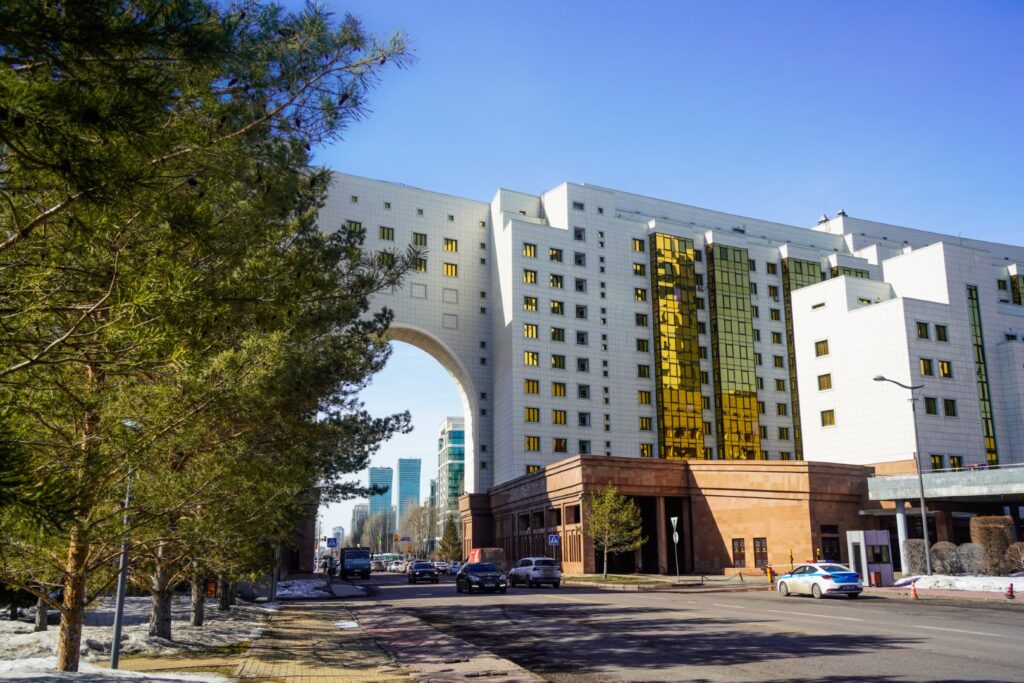
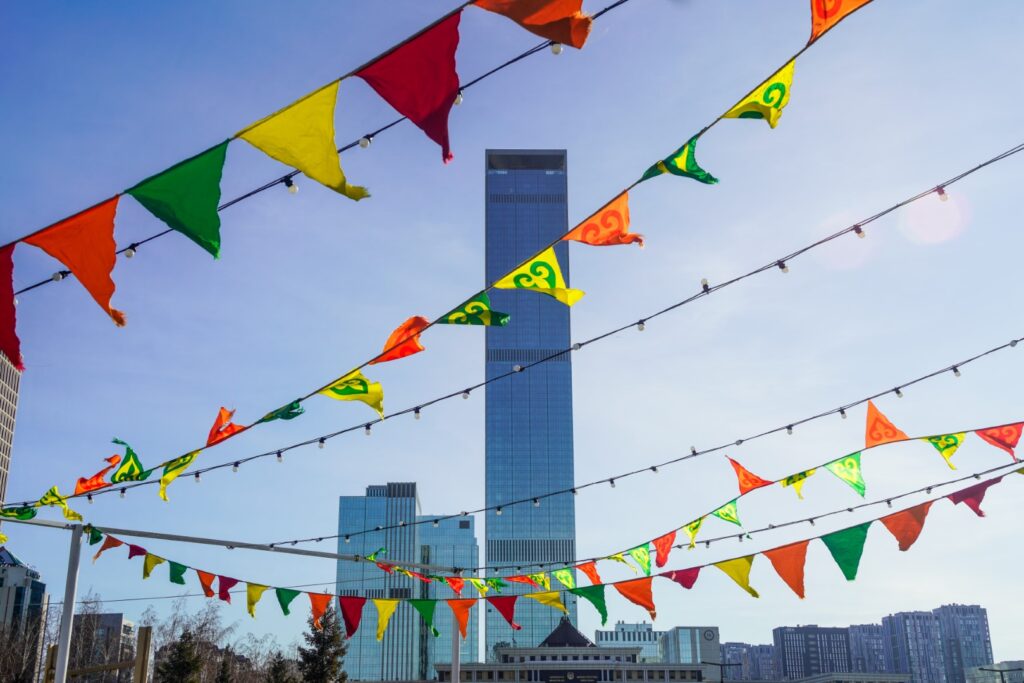

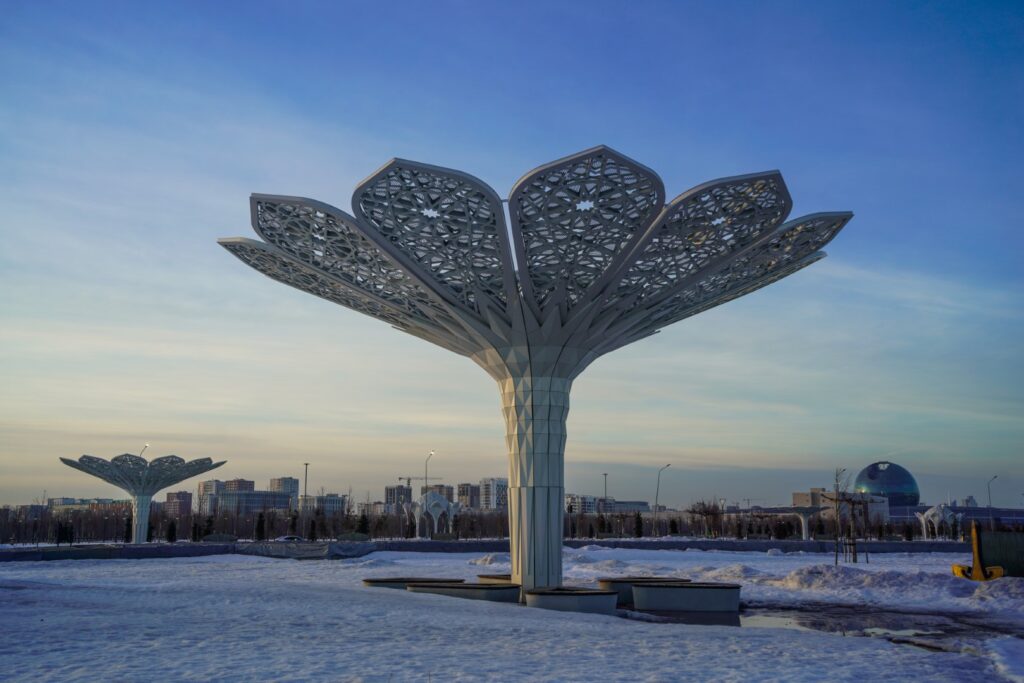
A skyline view
It was 6 PM by the time I stepped off the train in Astana. After a warm farewell hug with my cabin mate, I opened the Yandex app to call a taxi. As a solo female traveller, I usually try to steer clear of taxis, but I had two meetings lined up that evening and didn’t have the time to wait for public transport. Fortunately, Yandex feels relatively safe – the app tracks your ride in real-time and includes a built-in emergency button. My driver was kind and did his best to offer travel tips in his limited English. The ride to my hotel, just 14 kilometres away, took nearly an hour due to high traffic, and cost just 3,000 tenge (~ 39 DKK).
For my night in Astana, I’d decided to treat myself and booked a room at the Altyn Eco Park, a fancy skyscraper hotel. At 23,700 tenge (~ 305 DKK) per night, it wasn’t expensive by European standards, though quite high by local ones. But it was absolutely worth it. My room on the 9th floor offered a stunning view of the city’s skyline, and the breakfast buffet – located on the 17th (!!) floor – was a real highlight. The hotel also had excellent WiFi, which is something of a rarity in this region, so I was finally able to catch up on some work.
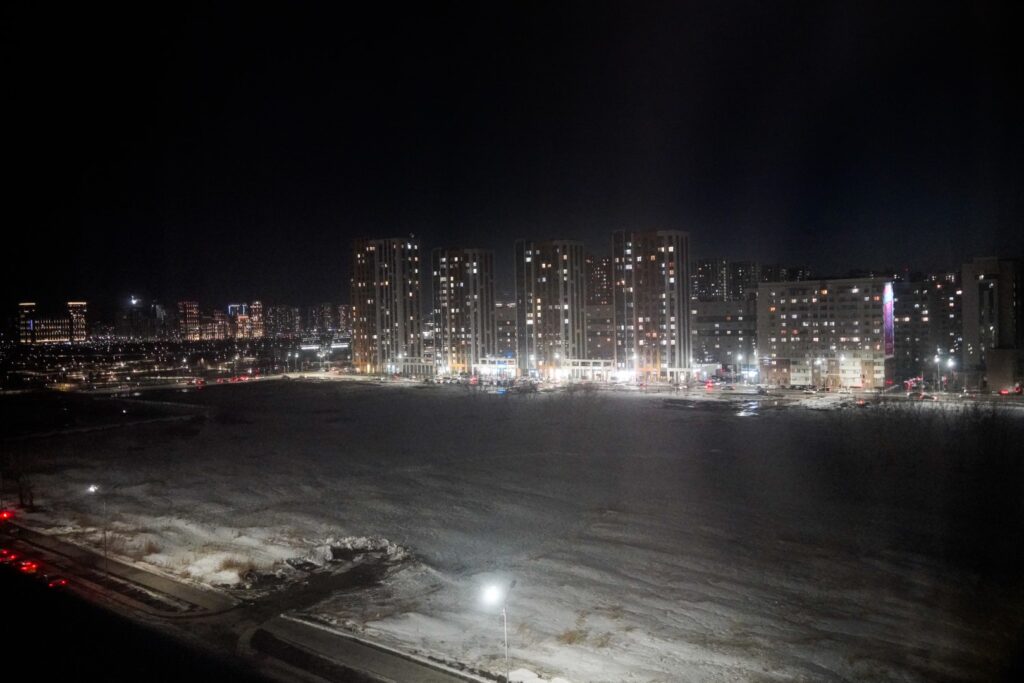
Abu Dhabi Plaza and the tallest building in Central Asia
I checked out of the hotel at noon the next day, after enjoying a slow morning – sleeping in, getting a bit of work done, and savouring a delicious breakfast while soaking in the view of the city below. Then it was time to hit the streets and explore!
My first stop was Lineinyi Park, where I got a fantastic view of Astana’s towering skyscrapers rising above the snowy landscape. After sweating through my journey in Uzbekistan and southwestern Kazakhstan, it felt amazing to finally be somewhere cold – I was honestly thrilled to bundle up again!
Just across from the park stands the massive Abu Dhabi Plaza, a sprawling complex of shops, offices, residences, and a hotel. Built between 2011 and 2021, it’s home to the tallest building in Central Asia – a striking 320-metre tower. I went in hoping to find an observation deck or a way to the top, but unfortunately, everything seemed closed off to the public. So instead, I wandered through the mall and popped into a supermarket to grab a drink.

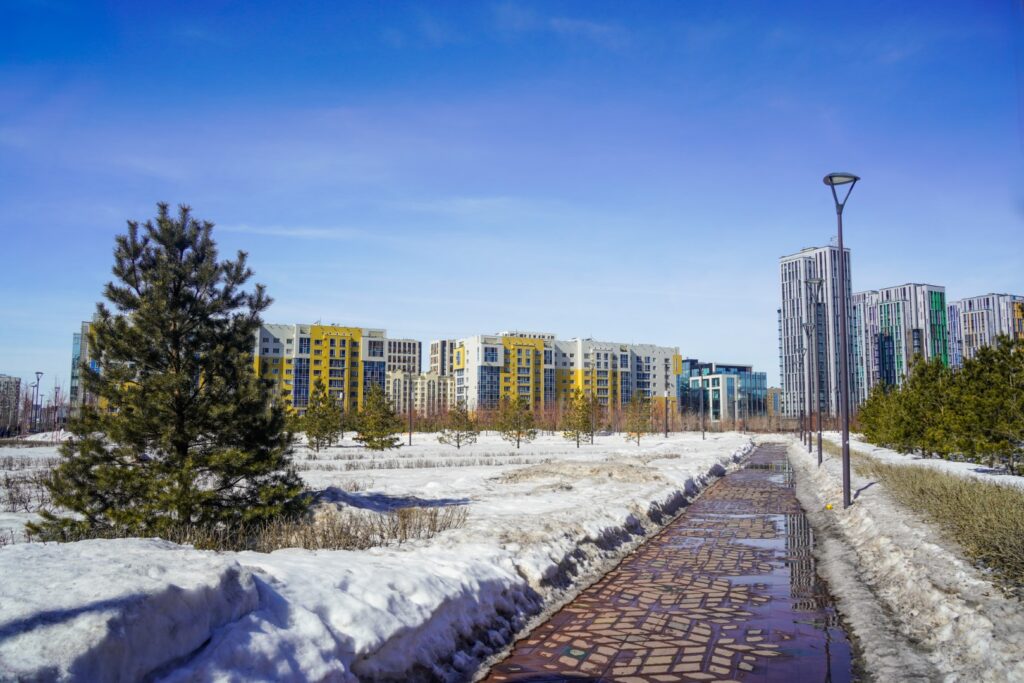
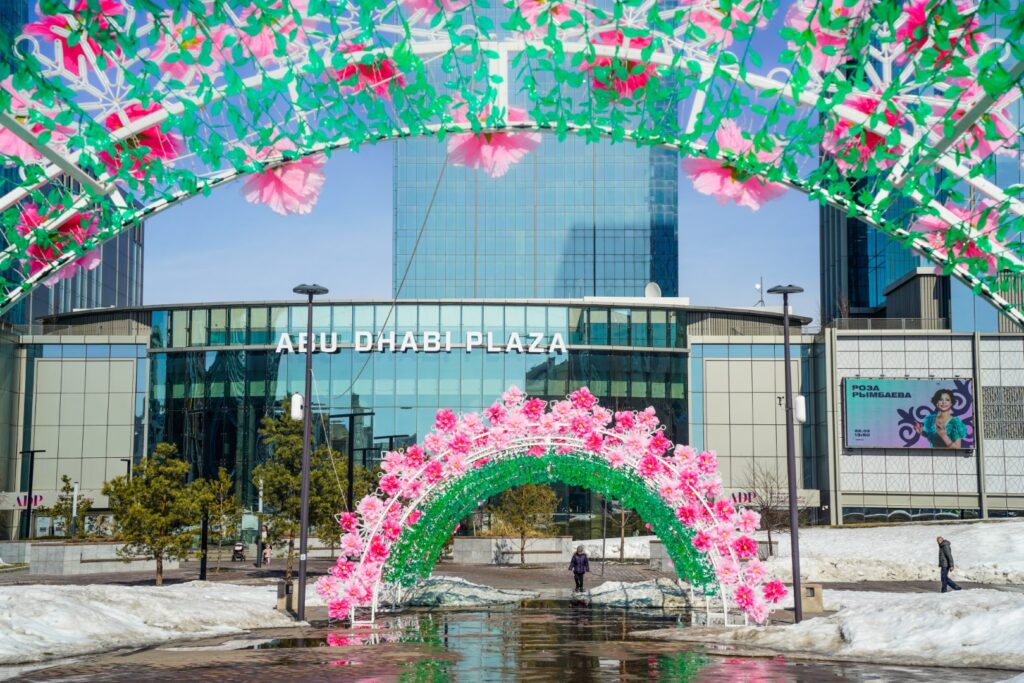
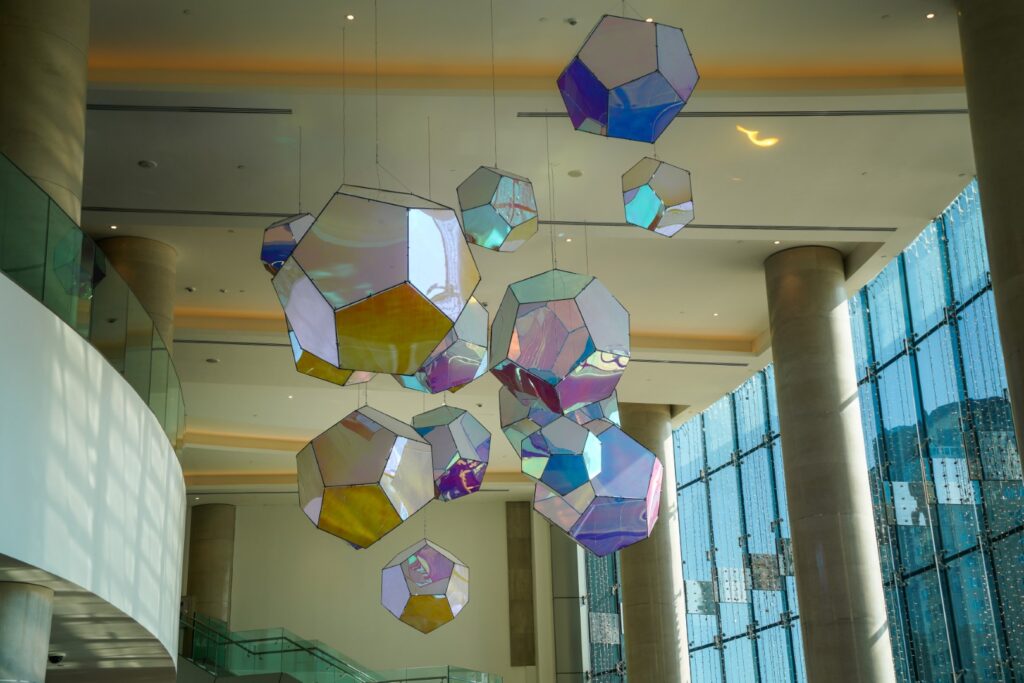
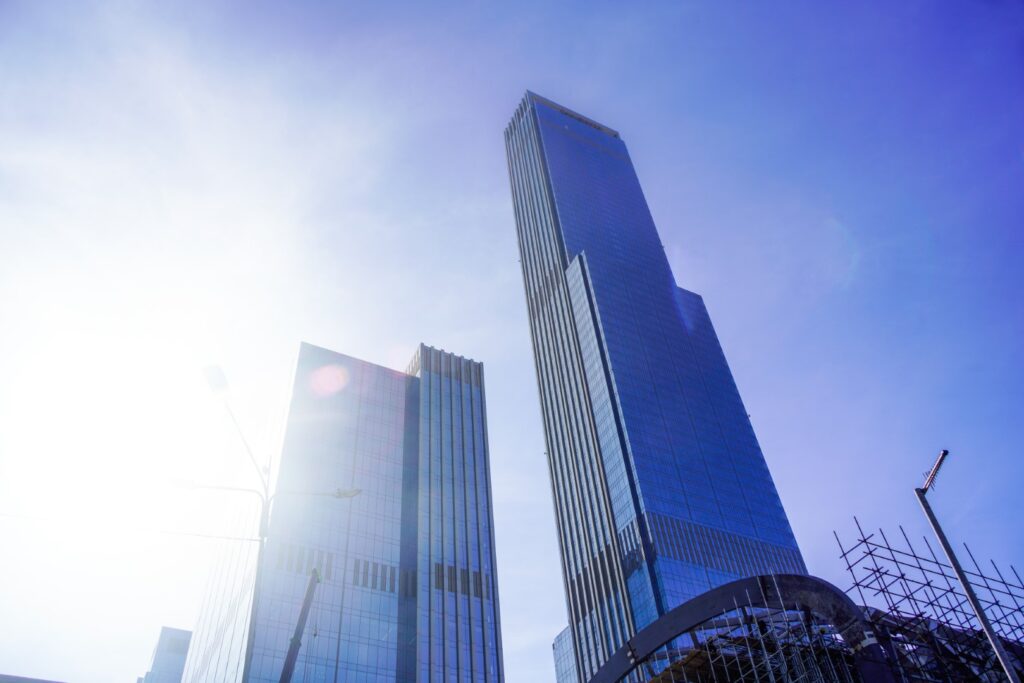
Akorda Presidential Palace and Atyrau Bridge
As I approached the Akorda Presidential Palace, I was surprised to find guards stationed at a considerable distance from the building itself. Curious, I asked one if I could take a photo – he gave a subtle nod of approval. The palace serves as the official workplace of the President of Kazakhstan, though it’s not his residence. Inaugurated in 2004, the Akorda sits prominently on the left bank of the Ishim River. Its most striking feature is a grand blue-and-gold dome topped with a spire. Atop it stands a golden sculpture of the sun with a steppe eagle soaring beneath.
Navigating Astana’s streets proved quite challenging. While certainly more pedestrian-friendly than most American cities, the layout isn’t exactly intuitive. I struggled to find a way onto the Atyrau Bridge to cross the Ishim River. After getting lost several times, I ended up following two women in the hopes they were heading the same way – thankfully, they were. Eventually, I made it up onto the bridge.
Crossing it, I enjoyed an impressive view: the Presidential Palace on one side, and on the other, the snowy expanse of Presidential Park, with the distinctive eye-shaped National Library nestled within it.
On the other side of the river, I quickly learned an important local lesson: stick to the cleared paths. What looked like a harmless shortcut through the snow turned into a messy ordeal – I sank deep into slush and mud not once, but twice, just steps away from the pavement. By the time I’d explored only a few corners of the city, my boots were muddier than after some of my longest hikes!
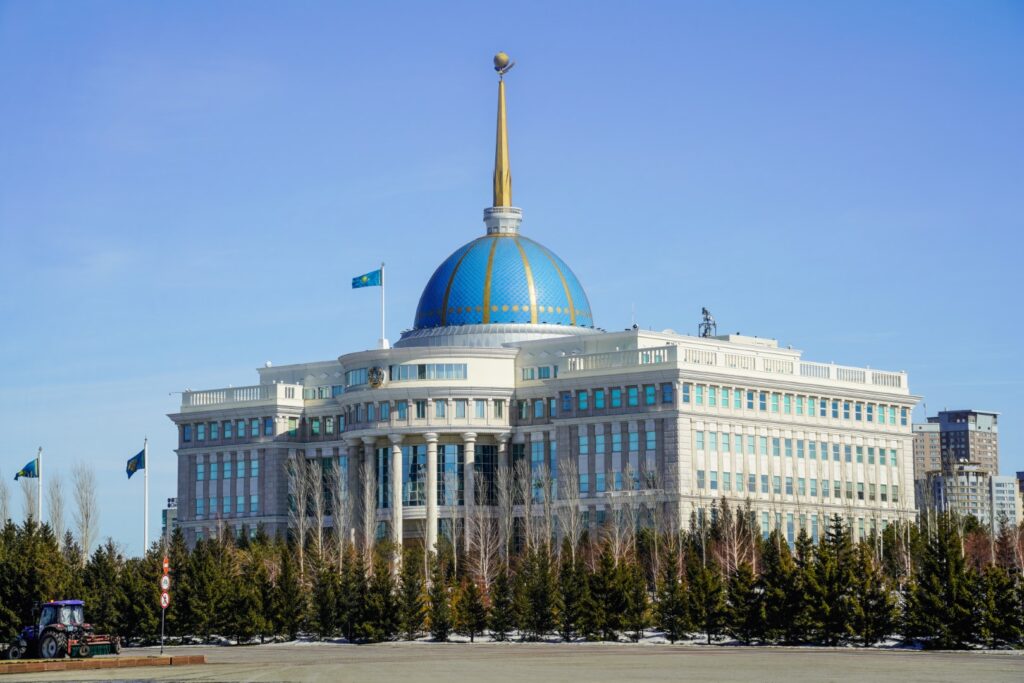
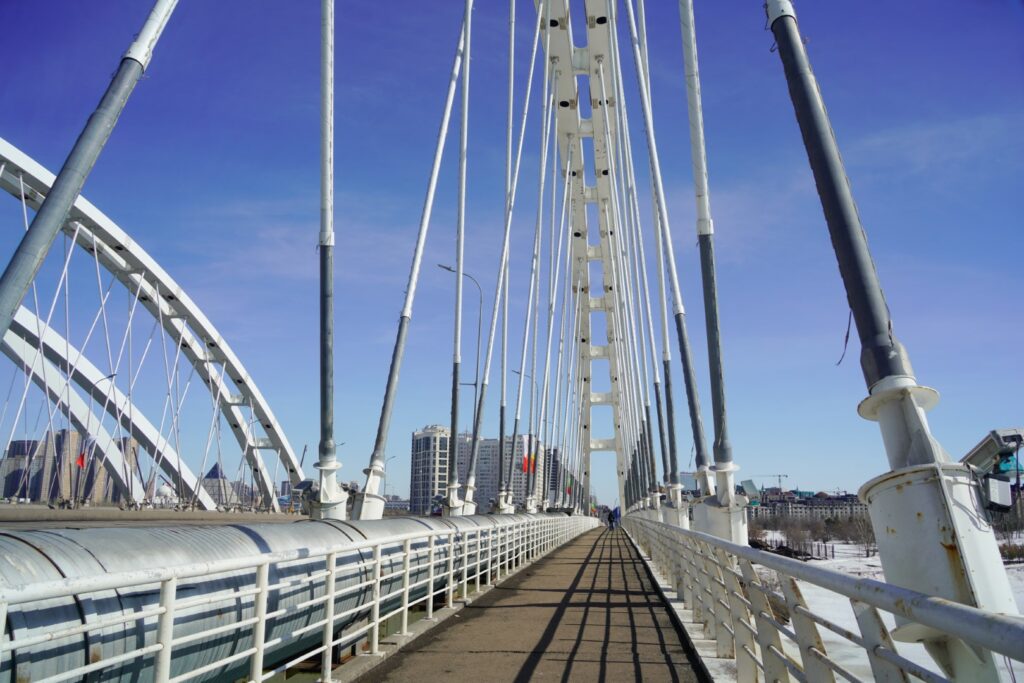
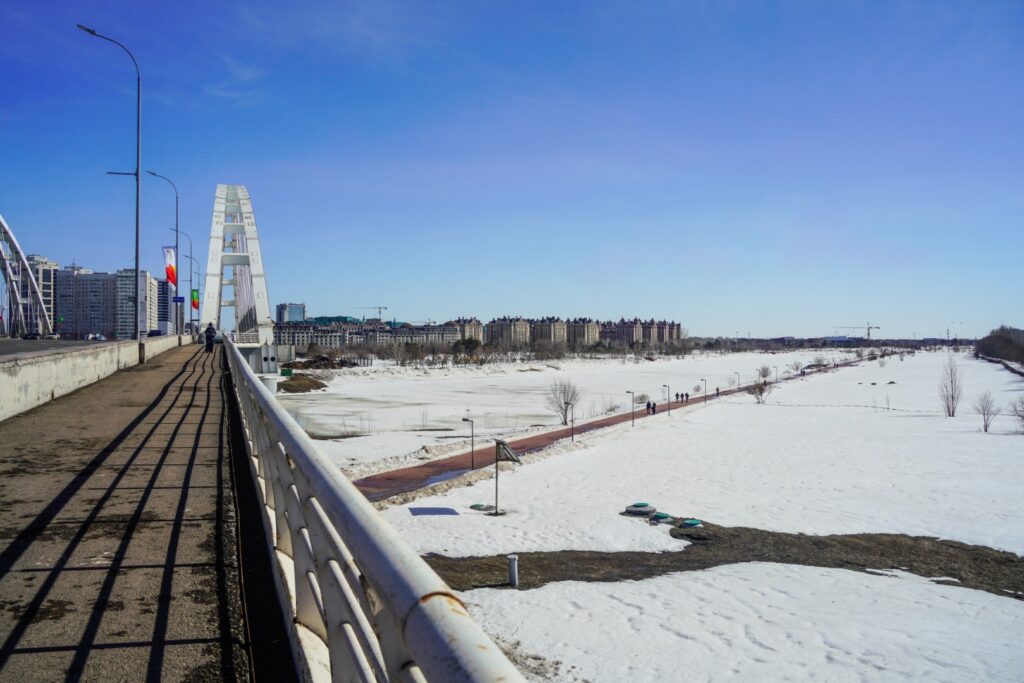
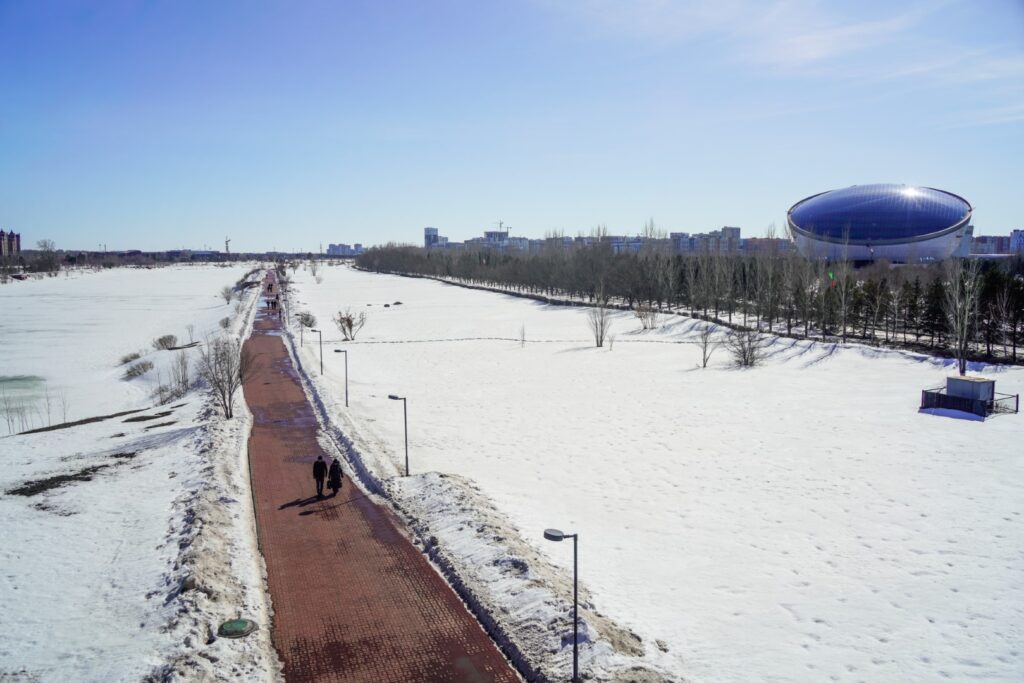
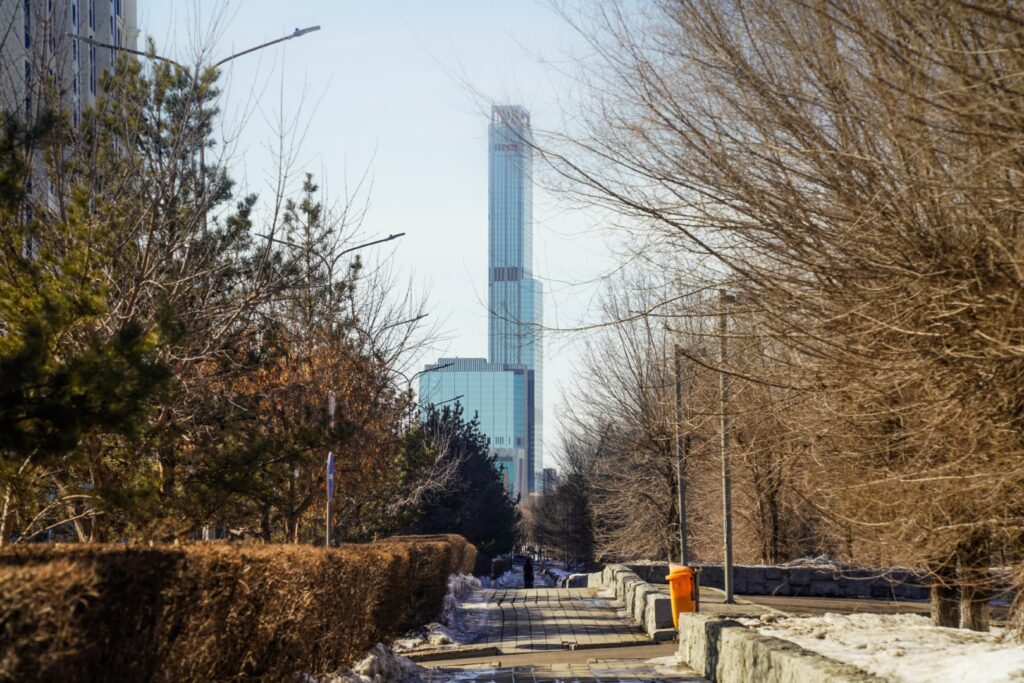
Independence Square and Hazrat Sultan Mosque
I walked nearly four kilometres east from the city centre to reach Independence Square, the main public plaza in Astana. Established in 2009, the square is home to several major landmarks, including the Kazakh Eli Monument – a towering symbol of the nation’s independence – and the Palace of Independence, which hosts state functions such as forums, meetings, and conventions.
Just beside the square stands the impressive Hazrat Sultan Mosque. Construction began in 2009 and was completed in 2012. Built in a classical Islamic style with distinctive Kazakh ornamental elements, it’s one of the largest mosques in Central Asia, capable of accommodating up to 10,000 worshippers.
Navigating the mosque’s interior was a bit confusing at first – a bit of a maze, really – but I simply followed a young woman inside, hoping she would lead me to the women’s entrance. She did. After removing my shoes and borrowing a headscarf, I made my way upstairs to the women’s prayer area, which overlooks the men’s section below. The mosque’s interior is truly stunning, grand yet serene. What struck me most, though, was how deeply local it felt. Despite its architectural grandeur, it wasn’t overrun with tourists – it felt like a space created for the community, not for spectacle.
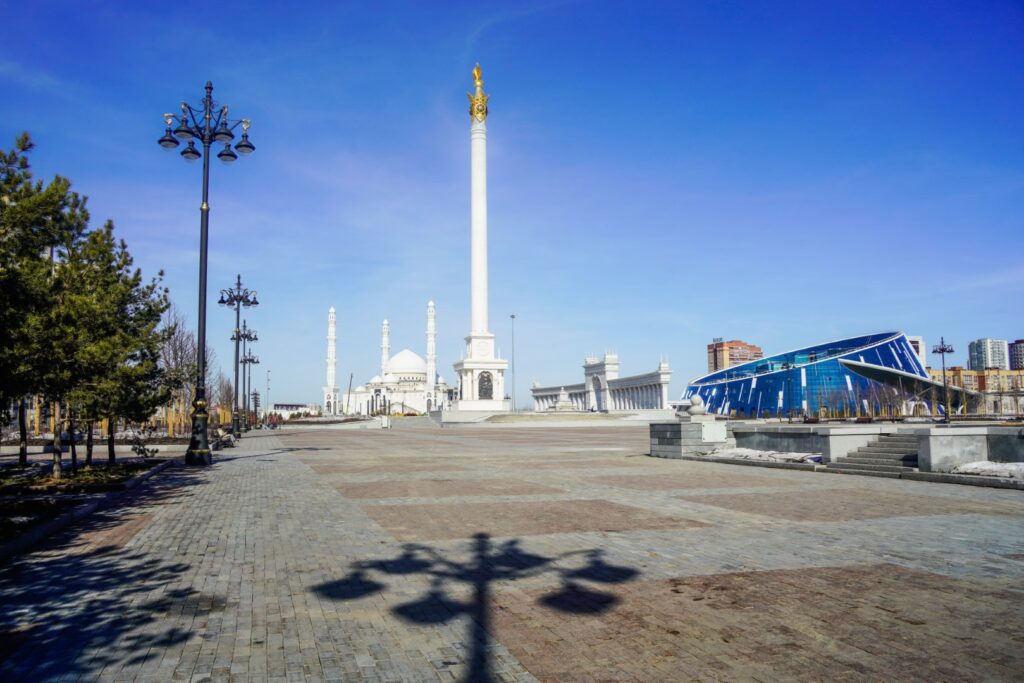
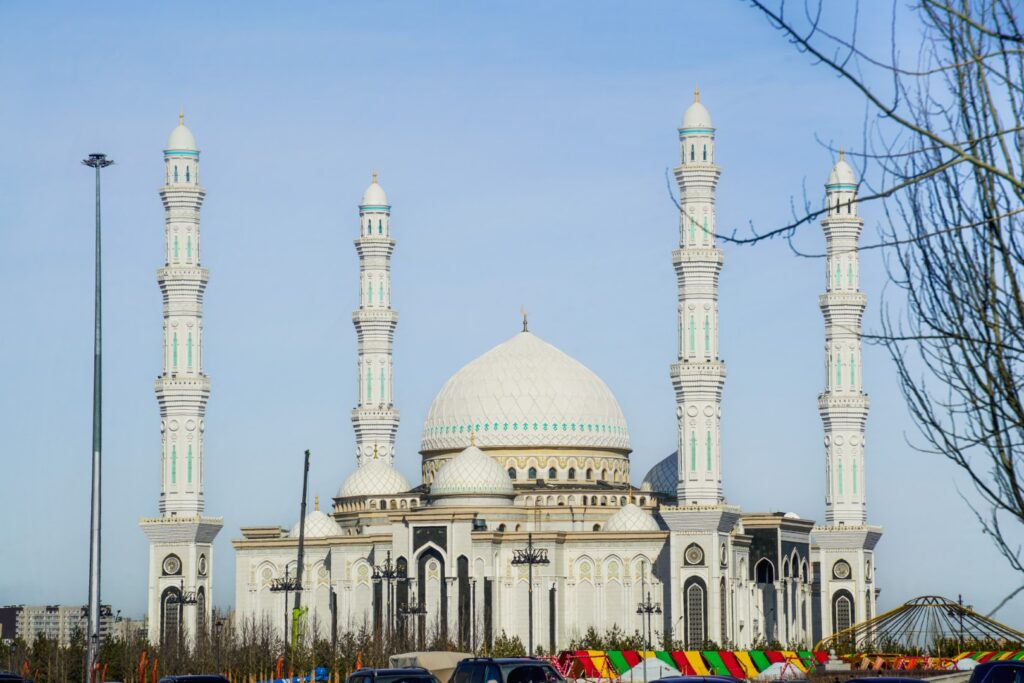
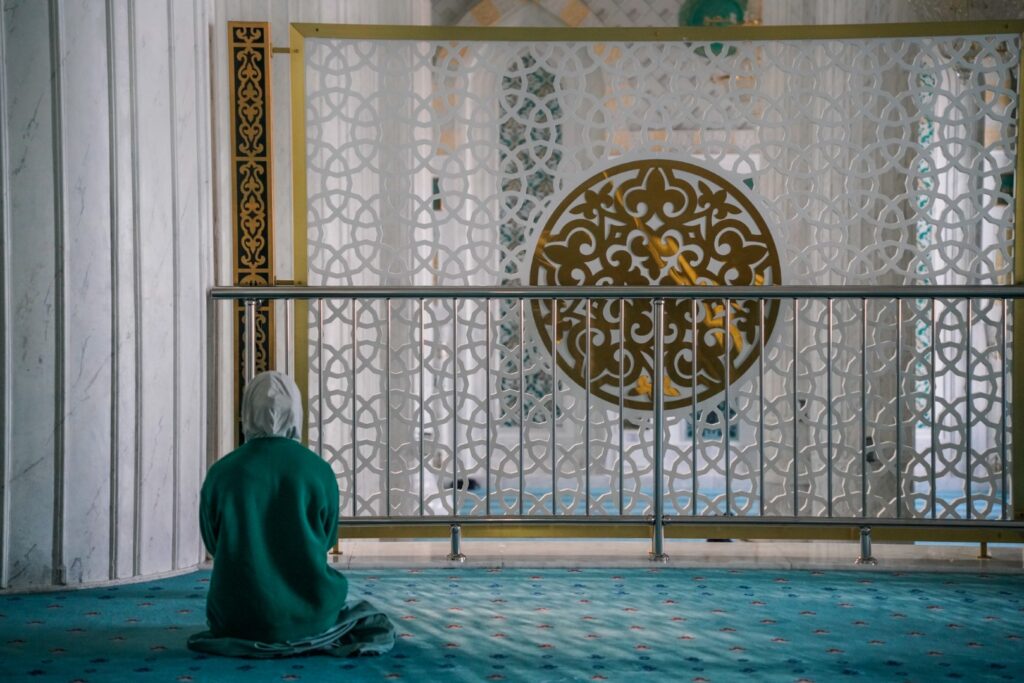

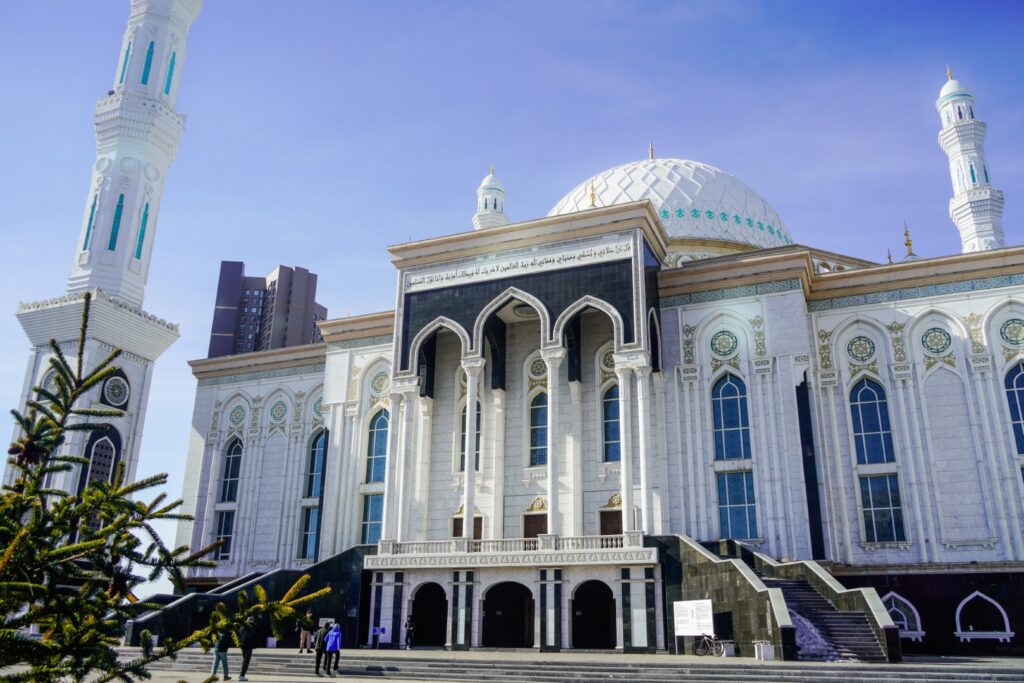
The glass pyramid and a gorgeous skyline view
Directly across from the Independence Square stands one of Astana’s most distinctive landmarks: the Palace of Peace and Reconciliation – a striking 62-metre-high glass pyramid. Completed in 2006, the palace was designed to host the triennial Congress of Leaders of World and Traditional Religions, an initiative aimed at fostering dialogue and cooperation among global faith leaders on key social, cultural, and religious issues. Since 2019, it has also served as a national, non-denominational spiritual centre and a venue for various public events.
Reaching the palace wasn’t exactly smooth. The walkways were buried under thick snow, and at one point, I slipped and fell on my back. By the time I finally made it to the palace – cold, flustered, and covered in snow – I discovered it was closed. But honestly, the climb was still worth it. The palace sits on a hill that offers what I thought was the best view in all of Astana – a sweeping panorama of the city’s futuristic skyline!
Eventually, I made my way back to the city centre, crossing the Arkhar Bridge. As I walked, I caught a final glimpse of the Presidential Palace from the opposite bank of the Ishim River – a quiet, majestic view.
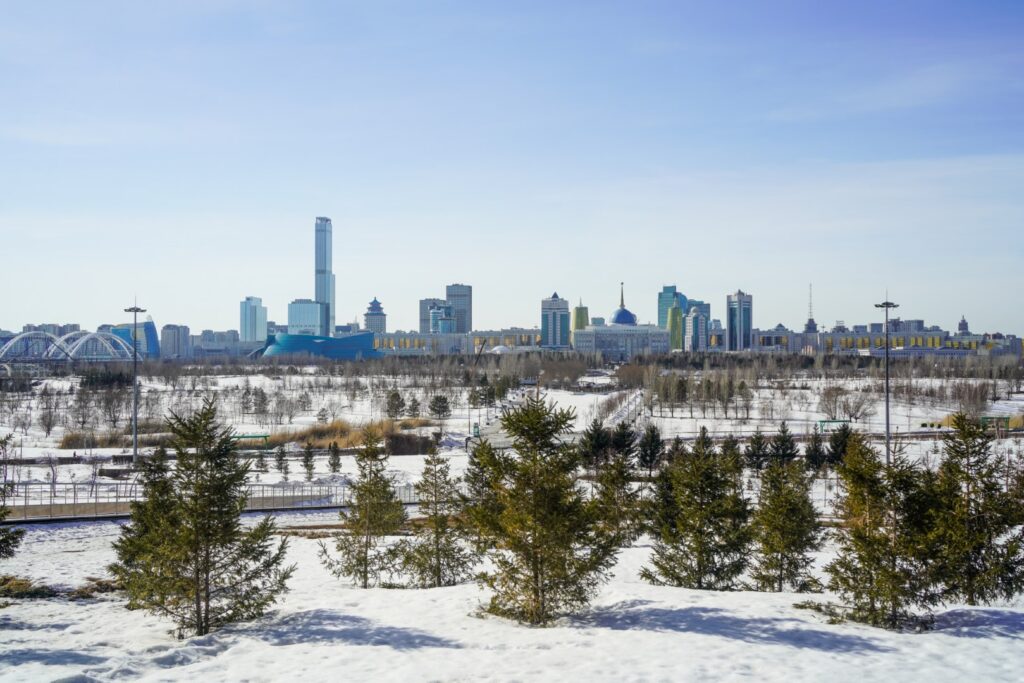

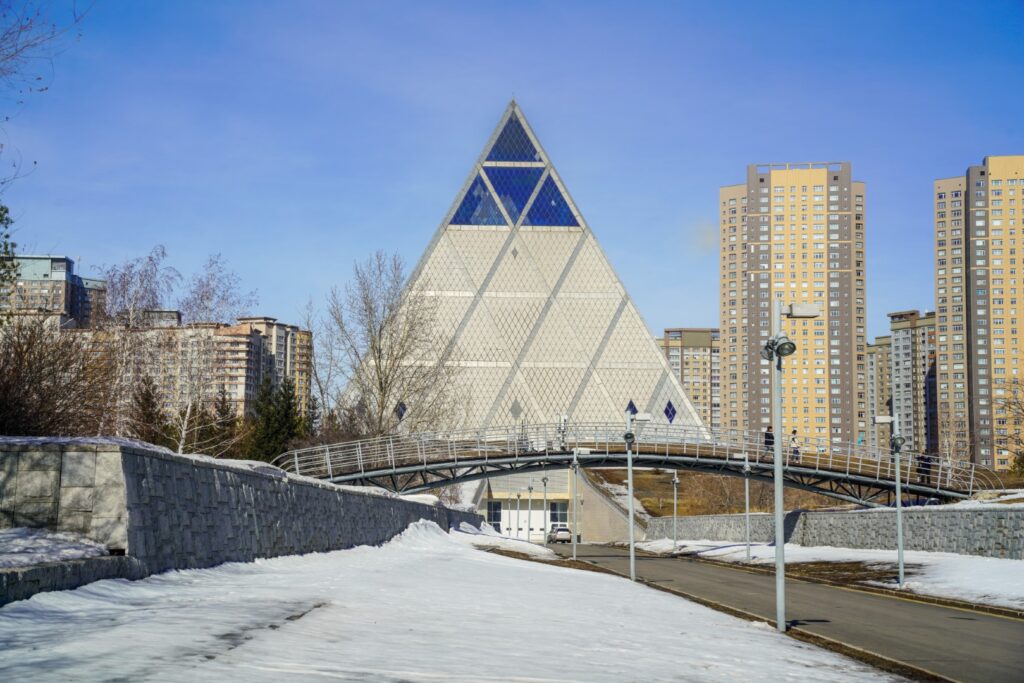
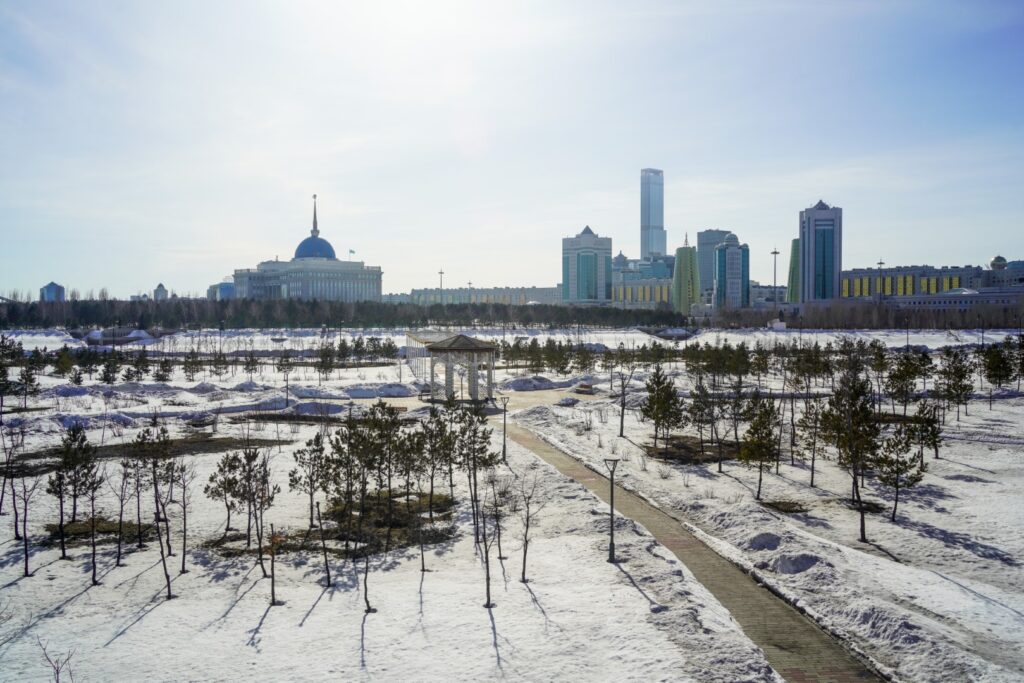
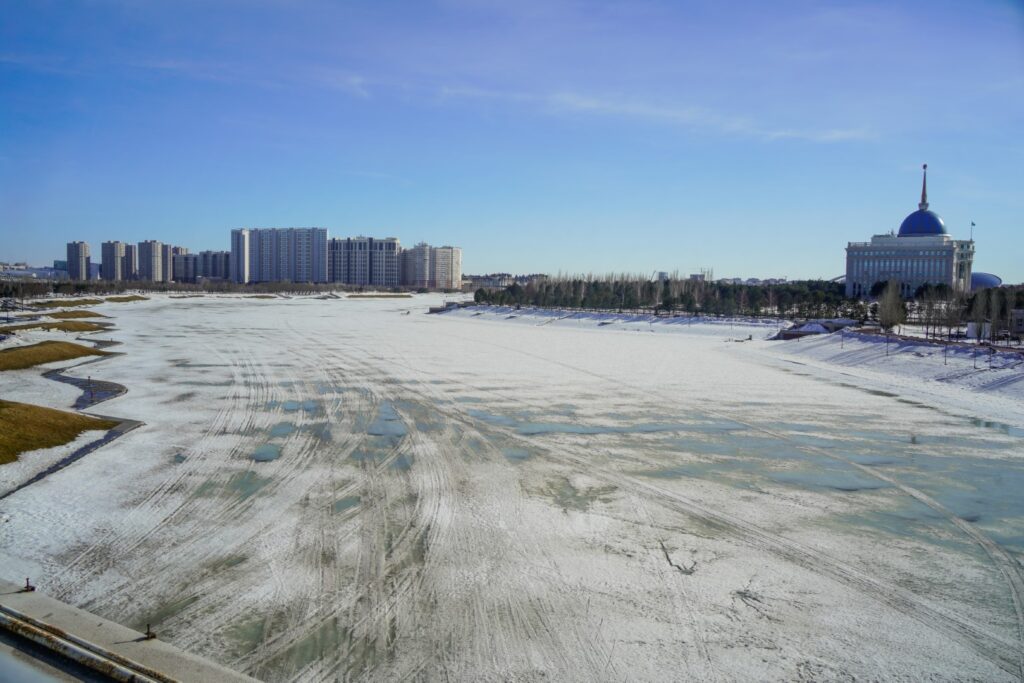
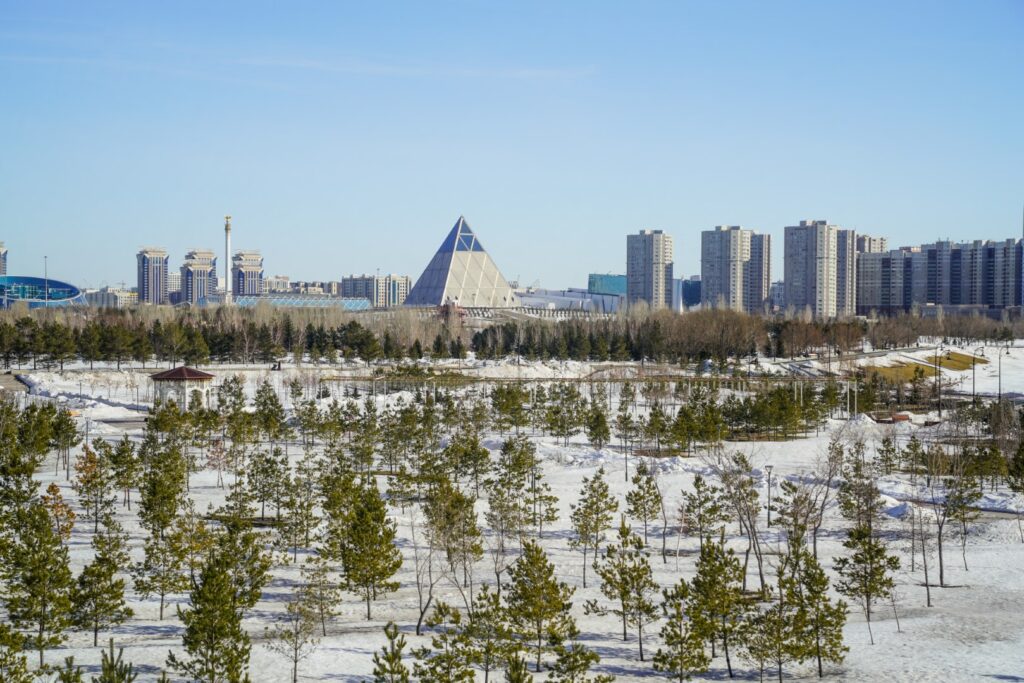
Baiterek and a 360-degree view
Next on my itinerary was Astana’s most iconic landmark: the Baiterek Monument. Symbolic of the city itself, this 105-metre-tall structure rises from a broad plaza. Its design is striking – a slender white shaft encircled by branch-like supports that flare outward near the top, cradling a giant golden sphere. At the base, there’s a ticket booth, and two elevators that take visitors up to the observation deck housed within the sphere. The main viewing platform sits 97 metres above ground and offers sweeping 360-degree views of the city and the endless steppe beyond. A short staircase leads to a second, smaller platform, where one can find a gilded imprint of the right hand of Nursultan Nazarbayev, the first president of independent Kazakhstan. A plaque invites you to place your hand in the mold and make a wish.
Entry cost me 2,000 tenge (~ 26 DKK), and after a quick security check, I was on my way up. The view from the top was absolutely worth it. From that height, you can fully appreciate the meticulous planning of Astana – the symmetry is almost surreal. The Presidential Palace sits dead centre, flanked perfectly by the gleaming twin Golden Towers. Aligned precisely behind it, the glass pyramid of the Palace of Peace and Reconciliation completes the axis. It reminded me a lot of Canberra – there’s something oddly compelling about cities that are this perfectly designed. They’re visually impressive but feel strangely hollow.
Looking out beyond the city was perhaps even more striking. The skyline ends abruptly, giving way to endless flat steppe in every direction – no suburbs, no sprawl, just nothingness. From above, the contrast is dramatic. It really drives home how young and artificial Astana is.
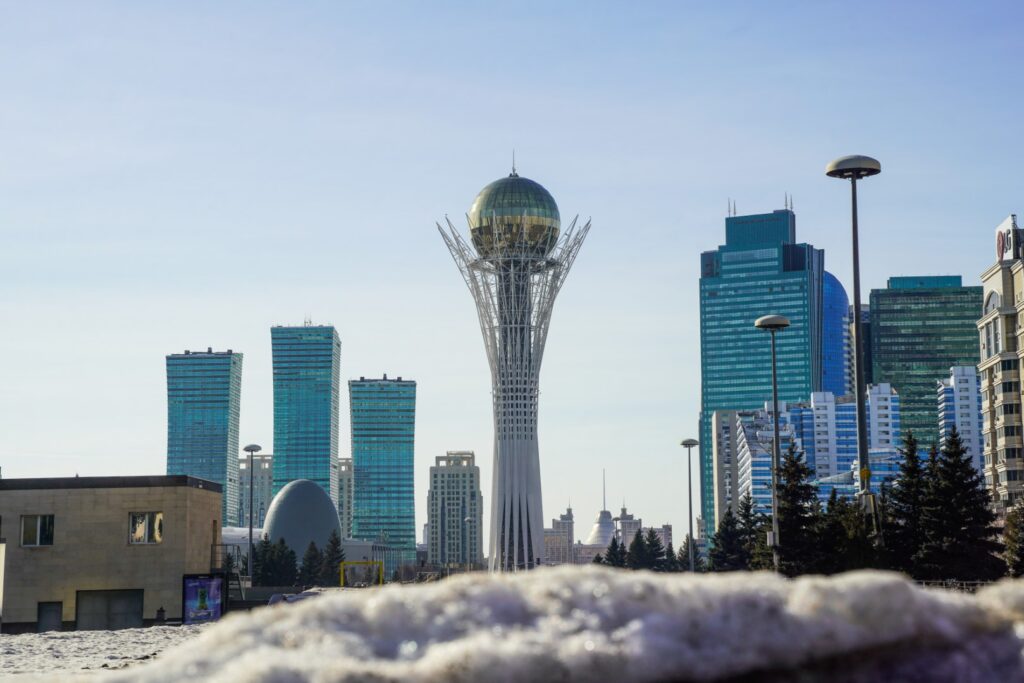
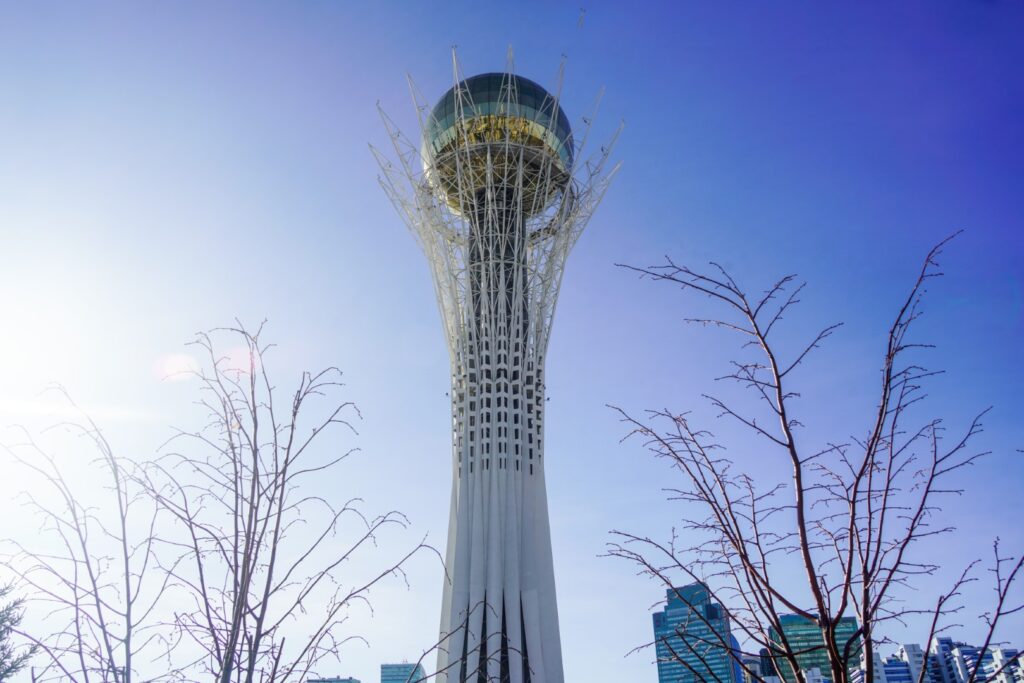
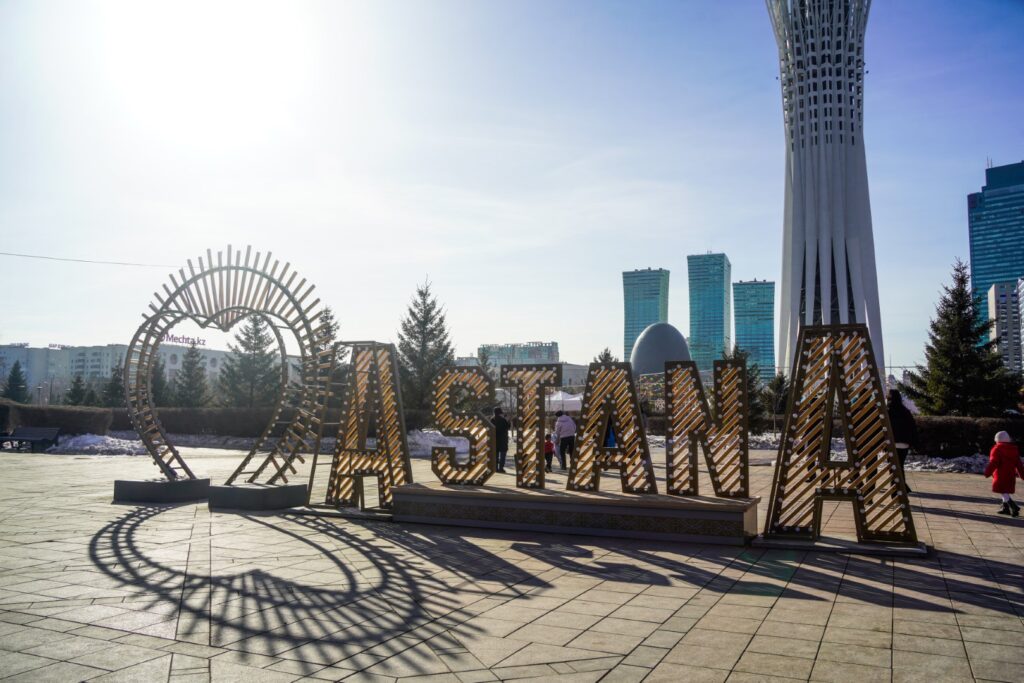
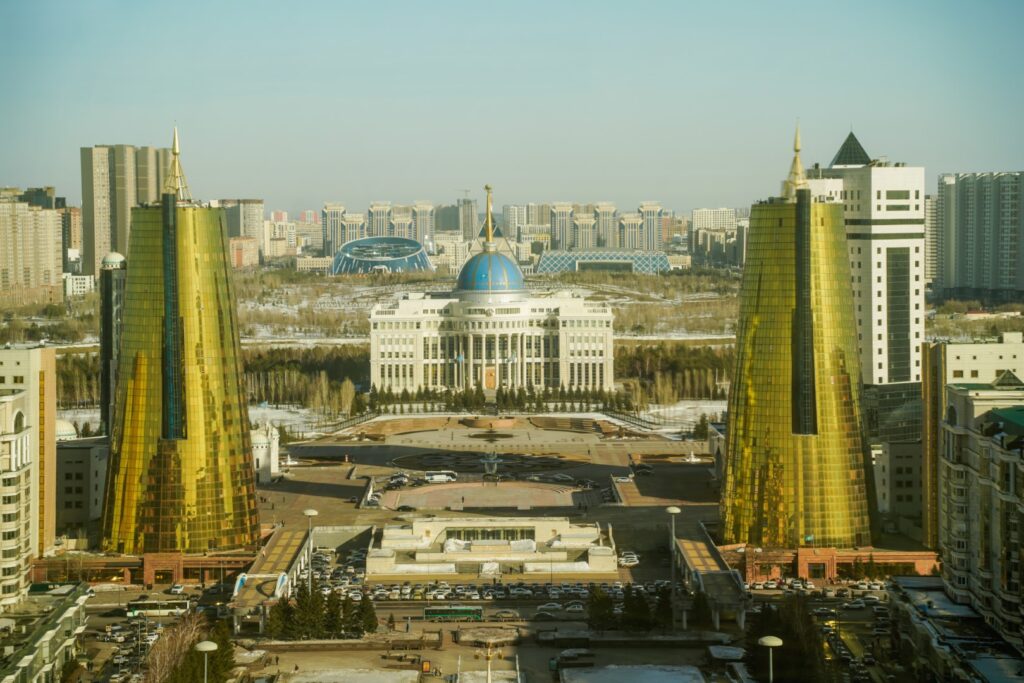
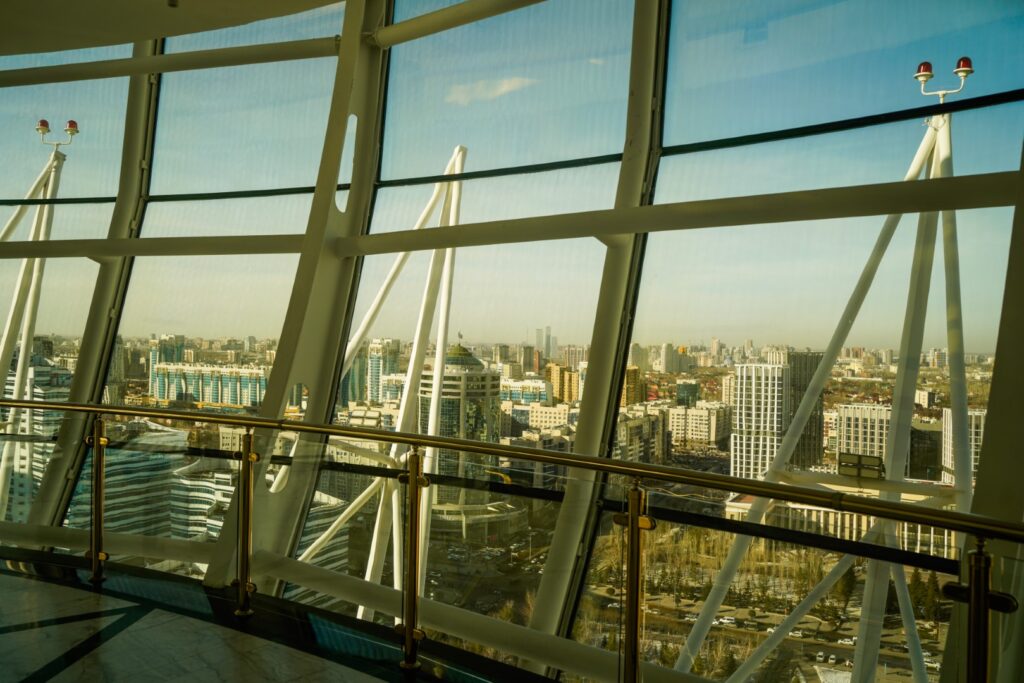
Khan Shatyr, a futuristic indoor city
I continued my walk along Nurzhol Boulevard, heading towards the headquarters of KazMunayGas – Kazakhstan’s state-owned oil and gas company. The building itself is striking, with its rose-tinted windows and stately design; frankly, it’s far too beautiful for a corporate oil giant. Framed perfectly through the grand archway at its centre is one of Astana’s most iconic structures: Khan Shatyr.
This futuristic, tent-shaped entertainment complex was unveiled in 2006 and built in a bold neo-futurist style. The “tent” soars 150 metres high above the base, which covers an enormous 140,000 square metres – roughly the size of 10 football fields. Inside the complex is an indoor city of sorts, complete with a park, cobbled walkways, a boating river, a shopping centre, a mini golf course, and even a beach resort!
I grabbed a bite to eat inside and then video-called my younger brother to show him the surreal sights of the city centre.


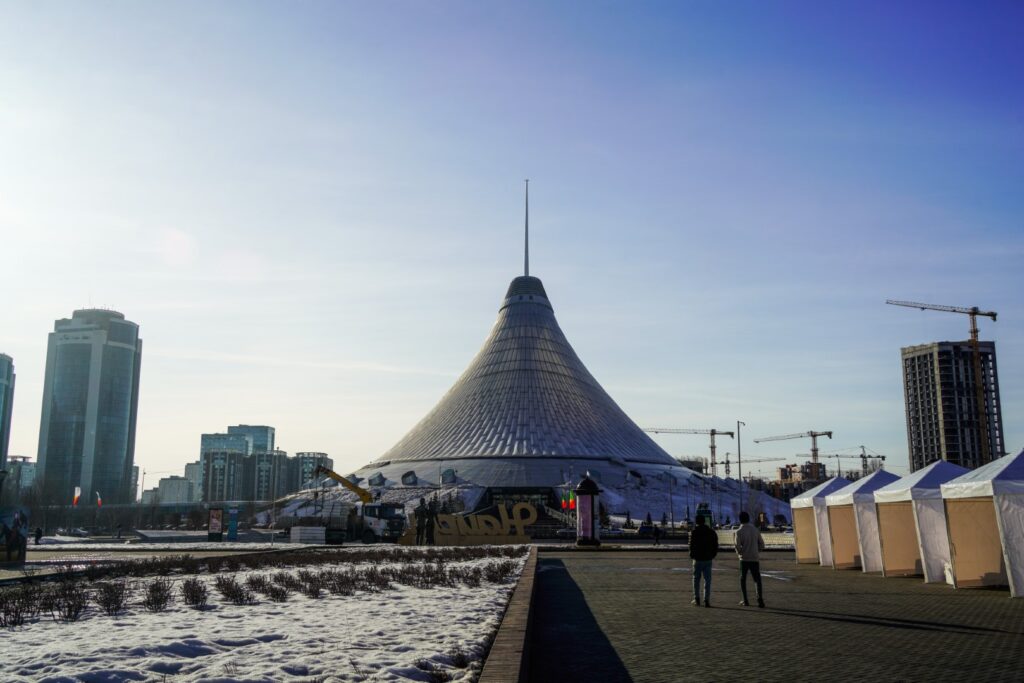
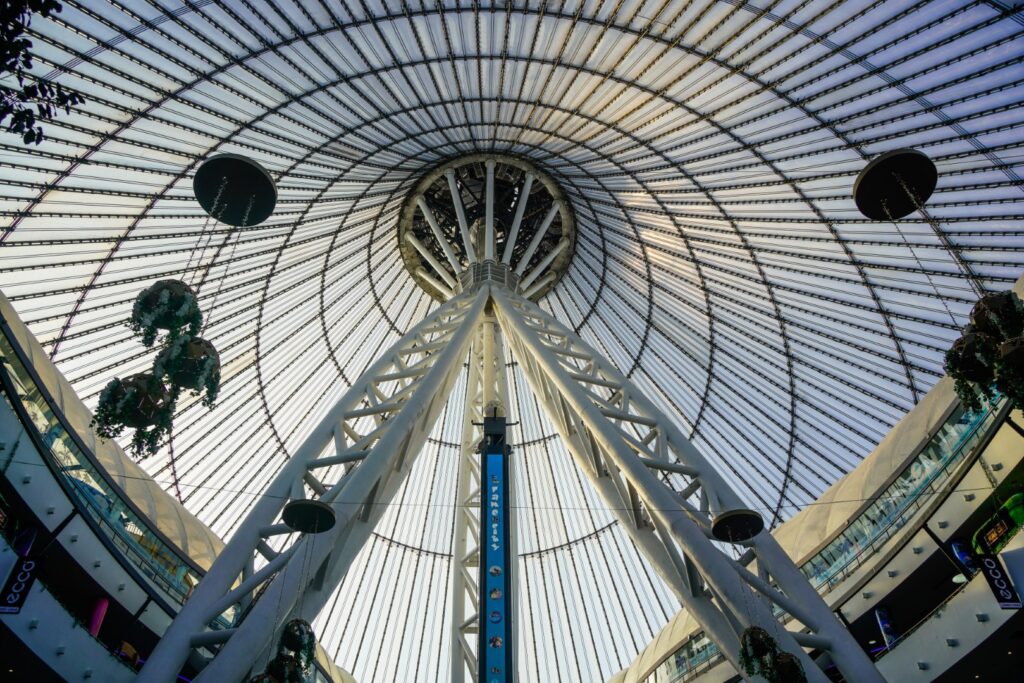
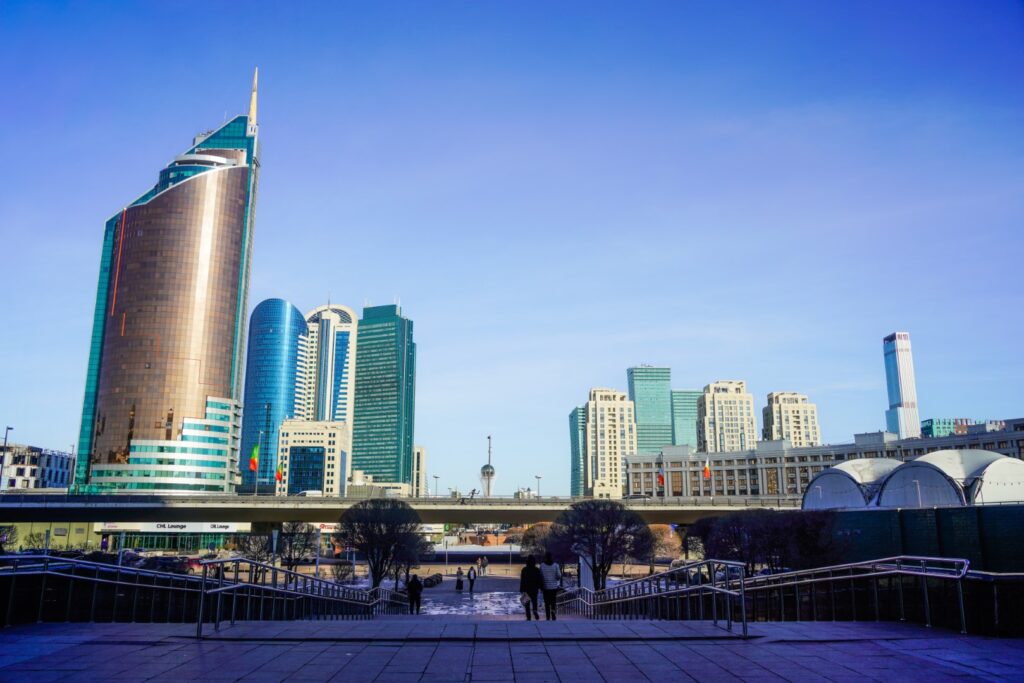
Sunset at the Grand Mosque
Time was running short, but there was one final stop I couldn’t miss – the Grand Mosque. It was over an hour and a half’s walk from where I was, so I called a Yandex and made it there in just 20 minutes, still chatting with my brother on the phone as we rolled through the city.
The mosque is nothing short of breathtaking. It’s not only the largest mosque in Central Asia, but also the second-largest outside the Middle East, and the seventh largest in the world. Its main dome is the largest of its kind in the world at 83 metres tall with a diameter of 62 metres, and it’s surrounded by four towering minarets, each rising 130 metres into the sky.
Even the entrance is monumental. The main door stands 12 metres high, making it one of the tallest wooden doors on the planet. Inside, the walls and dome are intricately adorned with colorful patterns, Qur’anic verses, and ornate prayers. The prayer halls are equally impressive – the main area and the women’s section are completely covered with Kazakh-designed ornamental carpets, totaling over 15,000 square metres.
I hung up the call and entered the mosque, where I had to remove my shoes and put on a long, blue hooded gown. With my camera slung over one shoulder and a backpack on the other, I definitely felt a bit out of place among the worshippers. This mosque was even more of a labyrinth than Hazrat Sultan, but after asking around, I eventually found my way to the women’s prayer area. I took a few photos, soaked in the atmosphere, and lingered for a moment in the quiet – but I didn’t have time to stay long. My night train to Almaty was calling.
As I left, I walked a little distance away to get a full view of the mosque. The sun was setting just beside it, casting a warm glow over the impressive structure. It was the perfect, peaceful ending to my day in Astana.
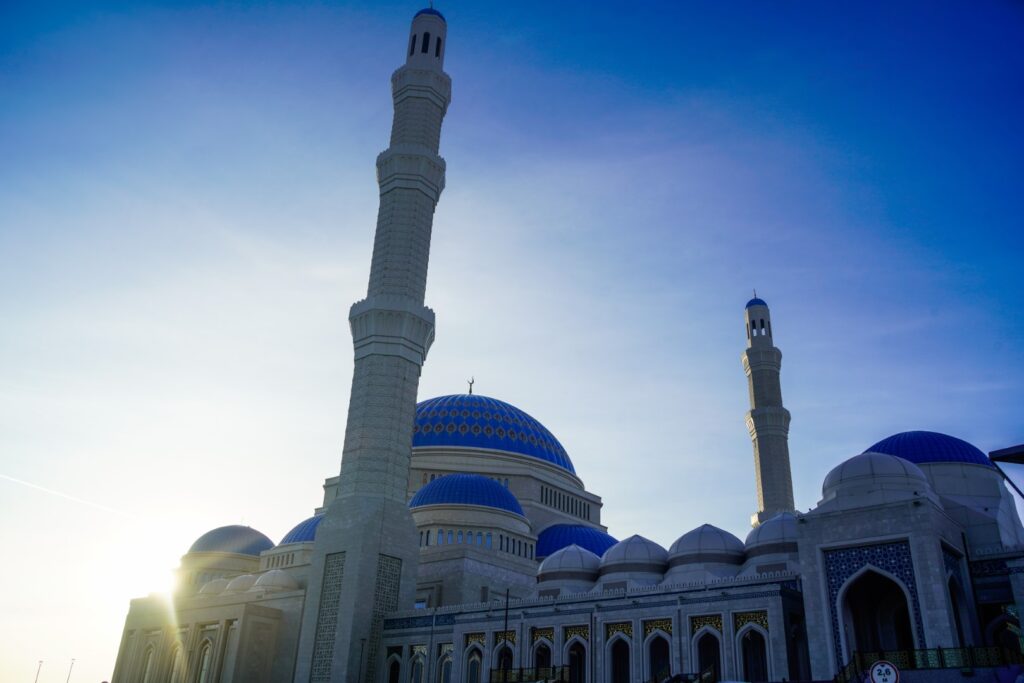
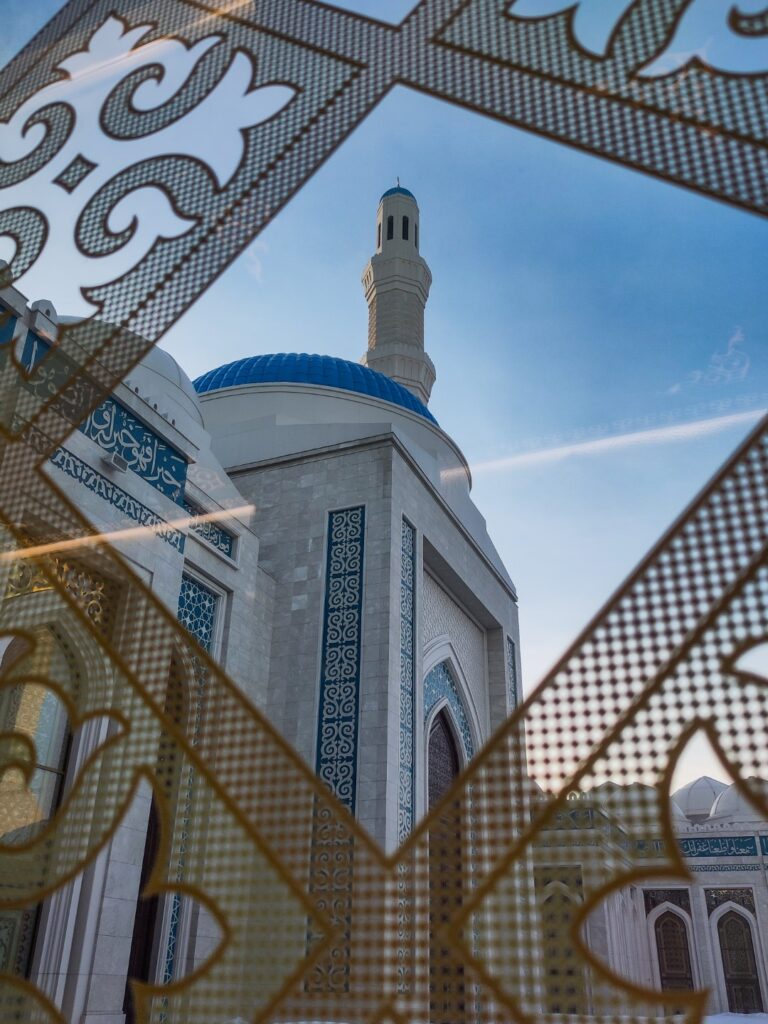
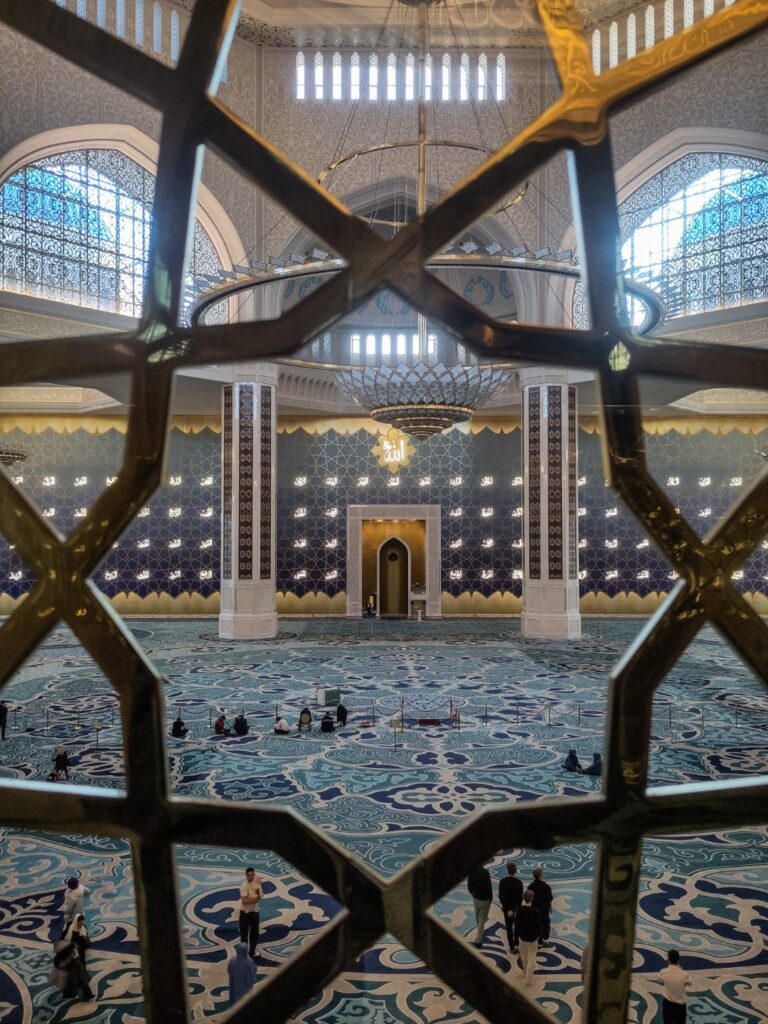
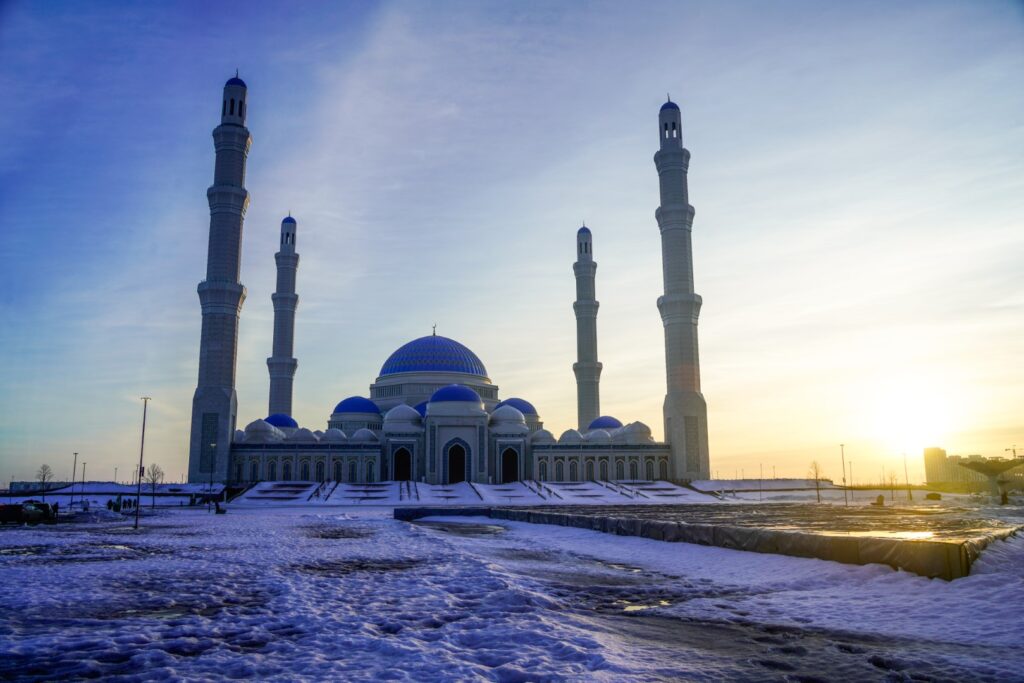
Farewell, Astana
I called another Yandex and rang my brother again – he kept me company as I raced back to the hotel to grab my bags. From there, I hurried over to Abu Dhabi Plaza for one last mission: to buy two beautiful mugs I’d spotted during my first visit to the mall – one for myself, and one for my friend Charlotte, whom I’d be seeing soon in Almaty.
With more than an hour to spare before my train, I ordered yet another Yandex. But this time, the driver took ages to arrive thanks to traffic congestion. Once we were finally moving, I started to relax – the route to the station wasn’t too bad after all, with just a few slowdowns. I arrived with half an hour to spare. That’s perfectly reasonable, though I always prefer to be a bit earlier when I’m navigating unfamiliar places.
I boarded the train and found my cabin, which I shared with three other women – one of whom spoke excellent English. And just like that, I was off to Almaty – the final stop on my whirlwind adventure through Uzbekistan and Kazakhstan.
Even though my time in Astana was brief, I feel like I managed to see everything I’d hoped to. It’s a city, plain and simple – bold, new, and not particularly steeped in history, which is what I tend to seek out in my travels. I’m a nature person at heart, and Astana doesn’t offer much in that department. So for me, a day was enough. Still, I’m really glad I made the effort. There’s something undeniably fascinating about Astana. It feels like a city from the future, plopped down in the middle of nowhere.
Leave a Comment
Pingback: Kazakhstan’s cultural heart: Exploring Almaty during Nowruz celebrations – Northtrotter on 24/05/2025
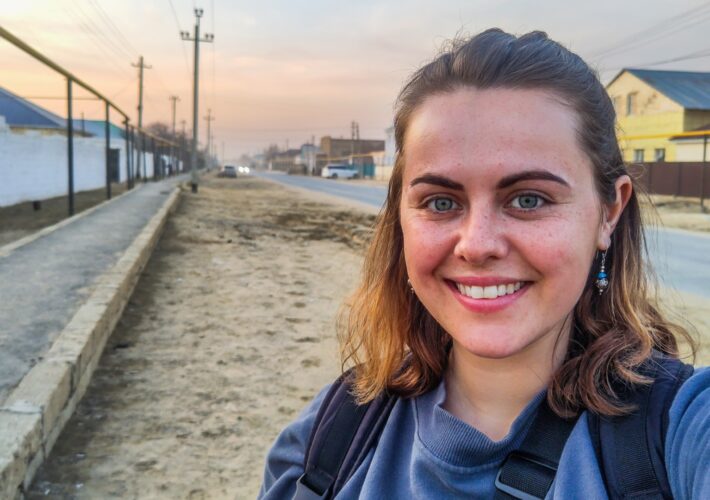
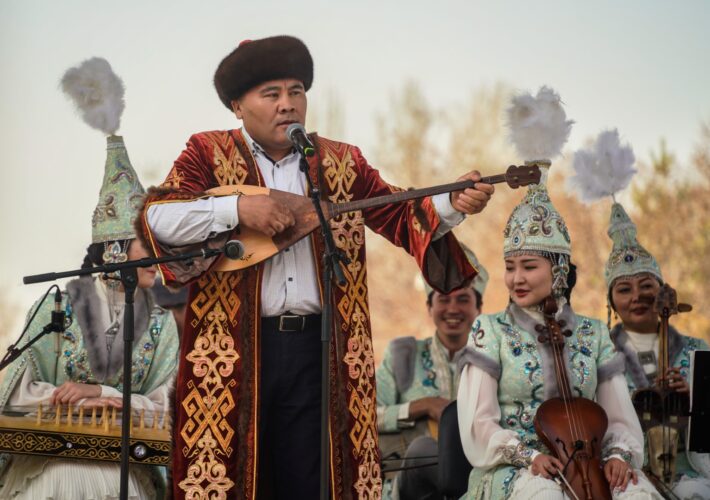
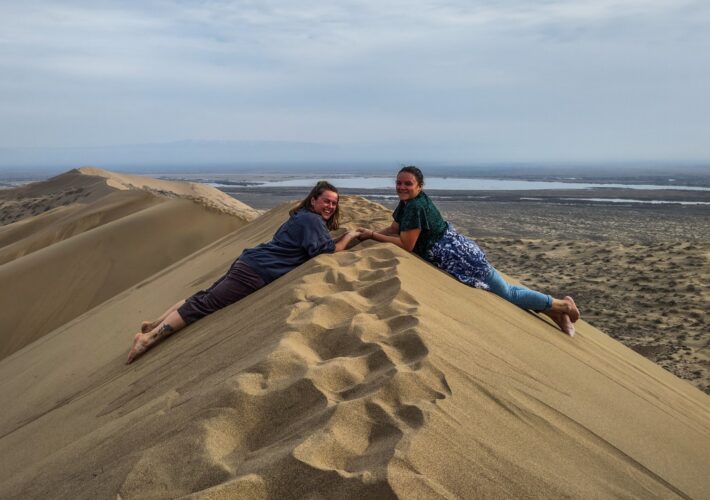
3 COMMENTS
Tadashi Hamada
3 weeks agoAstana may be the most underrated place ever, is it really that empty yet beautiful? Your work is really good, and I like that you just sat inside the mosque and felt some peace, wish you had more time for that. Anyways, I’m only a student who has been very fortunate but I envy your traveling, your blogs bring me a sense of peace. They’re very very good, I was interested in Faroe Islands once, searched on the web and somehow came to your blog, a very fine blog you have here. Please keep doing what you are doing and never stop.
Mel
3 weeks ago AUTHORHi Tadashi, thank you so much for your kind comment! Astana is indeed underrated, especially for city lovers! I wish you well on your studies and hope you’ll get to travel a lot in your future, including to the Faroes!